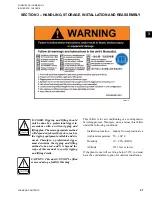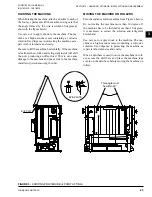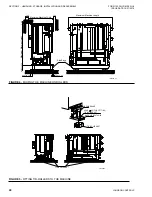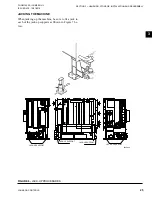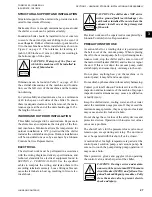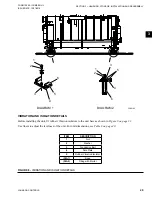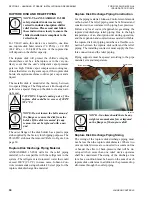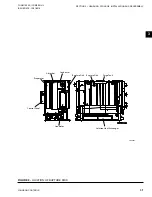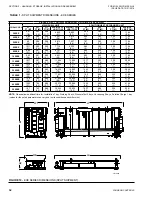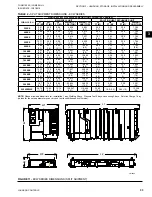
JOHNSON CONTROLS
18
FORM 155.30-ICOM2.EN.UL
ISSUE DATE: 12/21/2018
SECTION 2 – PRODUCT DESCRIPTION
GENERATOR
The generator section is of a falling film design. Such
a design ensures substantially reduced wear and tear
at the tube supports compared to the conventional
flooded design. The falling film design ensures supe-
rior heat transfer and extended tube life. It also reduces
the quantity of LiBr solution thereby ensuring reduced
startup time from a cold start. The stainless steel tubes
are arranged in a series counter flow arrangement al-
lowing for design with lower leaving hot water tem-
peratures.
The pre-heated dilute solution enters the generator on
the top of the generator tubes where it is heated by the
hot water (driving heat source) flowing through the
stainless steel tubes. The refrigerant (water) vapors mi-
grate to the condenser, leaving behind a concentrated
(strong) LiBr solution, which is then cooled before be-
ing distributed in the upper absorber section.
LD19939a3
LD19839a3
Hot Water Out
Condenser
Generator
Dilute Solution In
Hot Water In
Concentrated
Solution Out
Dilute Solution In
Hot Water In
Concentrated Solution Out
Hot Water Out
CONDENSER
The refrigerant vapors leaving the generator condense
into liquid refrigerant in the condenser section, using
cooling (condenser) water. The liquid refrigerant water
is then distributed first in the lower evaporator section.
LD19939a4
LD19839a4
Condenser
Cooling Water Out
Condensed
Refrigerant Out
Condensed Refrigerant Out
Cooling Water Out
CRYSTALLIZATION
All absorption chillers that use lithium bromide and
water as the solution / refrigerant pair are subject to
crystallization. This is due to the fact that some areas
of the unit operate with solution liquid concentration
levels that are only possible at higher than the normal
ambient temperature surrounding the unit. For exam-
ple, the solution concentration in the generator of a
single stage absorption unit is typically 64.3% lithium
bromide by weight. LiBr solutions begin to crystallize
at 110°F.
Crystallization happens when the LiBr solution tem-
perature drops too low or the concentration is too high.
The LiBr solution becomes like slush. At this point the
LiBr solution can't absorb any more water and will
start to solidify (crystallize).
Crystallization occurs in the solution heat exchanger.
In addition, it may happen in the generator. It also hap-
pens in pipes that are not well insulated and are located
in rooms where the temperature can affect the solution
moving through the pipes.
You can prevent crystallization by making sure you
keep the solution temperature high and the concentra-
tion at the optimum percentage of less than 64%.
Содержание YHAU-CL Series
Страница 14: ...JOHNSON CONTROLS 14 FORM 155 30 ICOM2 EN UL ISSUE DATE 12 21 2018 THIS PAGE INTENTIONALLY LEFT BLANK...
Страница 20: ...JOHNSON CONTROLS 20 FORM 155 30 ICOM2 EN UL ISSUE DATE 12 21 2018 THIS PAGE INTENTIONALLY LEFT BLANK...
Страница 47: ...JOHNSON CONTROLS 47 SECTION 4 TECHNICAL DATA 4 THIS PAGE INTENTIONALLY LEFT BLANK...
Страница 102: ...JOHNSON CONTROLS 102 FORM 155 30 ICOM2 EN UL ISSUE DATE 12 21 2018 THIS PAGE INTENTIONALLY LEFT BLANK...
Страница 128: ...JOHNSON CONTROLS 128 FORM 155 30 ICOM2 EN UL ISSUE DATE 12 21 2018 THIS PAGE INTENTIONALLY LEFT BLANK...


















